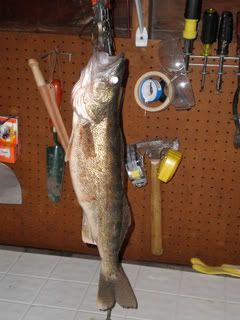
We hear so much about fishing points, inside and outside turns, underwater humps and rock piles that we tend to forget about one of the most productive areas in any given body of water and especially true on Canadian Shield lakes. I am not talking about an area that holds fish occasionally and should be checked once in awhile, but an area that is dynamite throughout the seasons and should be part of your strategy for taking walleye consistently.
Flats, that's right, those mostly featureless and presumably barren stretches of lake bed that apparently offer nothing for the average angler to key in on. Flats are the least interesting feature in a lake, reservoir, or river. No major structure, just flat bottom. Here's the kicker, flats hold the most active walleyes during most of the yearly periods. Flats are the major food producing regions of most lakes. Flats are the home of walleyes.
Flats teem with fish life, During the day, flats are home to schools of minnows and young gamefish that are feeding on plankton and insect larvae. Further up the food chain are schools of perch that equally content to eat insects and small fish. And somewhere close to all of this wonderful food are walleyes and plenty of 'em.
Ok, so maybe just maybe I 've convinced you to buy into the possibility that walleyes roam the flats. Boring, right? Wrong, action and some of the best and biggest action can be had on flats.
Fishing strategy is simple. The best way to find flats is to look at a contour map and observe where the contours are spaced far apart, close contours indicate sharp breaks.
Cover water, using your electronics as your eyes, you are not ready to wet a line yet. Pay attention to what depths you are marking fish. You will find that the majority of fish will be in that range.
Good flats all have some structural features, no matter how subtle. Could be little outcroppings of rock, wood. weed beds, or changes in bottom composition. Once you have given the flat the once over and determined the depth the fish are using, you are ready to start fishing. Don't worry about how many fish you marked. One or two is all you need to see. Trust me, they are there. Keep in mind that the cone angle of your fish locator has a small radius in mid to shallow depths and the fish are scattered, so you won't see as many as you would on point or hump.
The best presentation to use on a flat is a quick one. Trolling is supreme on flats. I like to use a bottom bouncer with a spinnner rig tipped. For most of the season, I find crawlers produce real well. Leeches and minnows work good as well.
Trolling crank baits, or using a snap jigging approach can be very productive as well. Keep moving, play with speed. After taking some fish, bump it up a notch, finally increasing to the point you where you determine that you are going to fast. Surprising how fast is too fast. Hang on to that rod, cause the hit is like a ton of bricks.
Don't sell the flats short, give them some effort. You'll be rewarded. And you know what, you'll have them all to yourself, most anglers stay away from them like the plague. For More information on this and other walleye questions check out Phil Rolfe at 807-468-5262 or check Witch Bay Camp web site atWitch Bay Camp http://www.fishinfo.com/witchbay.
read a great Hub entitled Best Walleye Fishing

